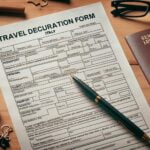As the world continues to navigate the challenges posed by the COVID-19 pandemic, travel has become more complex, especially when it comes to international movement. Italy, renowned for its rich culture, history, and scenic landscapes, remains a sought-after destination for travelers from around the globe.
However, in order to ensure the safety of both residents and visitors, the Italian government has implemented strict guidelines for those traveling to Italy from abroad. One such requirement is the self-declaration form for travel to Italy from abroad.
Travelers planning a trip to Italy must be aware of the necessary documentation and protocols that are in place before embarking on their journey. The self-declaration form is a crucial component in this process and plays a significant role in ensuring compliance with current regulations.
Understanding the purpose and importance of the self-declaration form is essential for any traveler heading to Italy. This document serves as a means for individuals to declare their reasons for entering Italy and provides authorities with vital information regarding their health status and recent travel history.
Failure to complete this form accurately and truthfully can result in potential delays or even denial of entry into Italy. Therefore, it is imperative that travelers familiarize themselves with this requirement and adhere to the established guidelines.
Understanding the Self-Declaration Form
When traveling to Italy from abroad, it is essential to understand the self-declaration form and its significance in ensuring a smooth and safe travel experience. The self-declaration form for travel to Italy from abroad is a mandatory document that travelers must fill out before entering the country. This form is designed to provide authorities with necessary information about the traveler, including personal details, contact information, and travel itinerary.
The self-declaration form serves as a declaration by the traveler that they are entering Italy for specific reasons and that they have not been in close contact with anyone infected with COVID-19. By completing this form truthfully and accurately, travelers are affirming their compliance with Italian regulations and their commitment to safeguarding public health.
Familiarizing oneself with the self-declaration form is crucial for all travelers planning to visit Italy. It is important to carefully read and understand the questions on the form before providing responses. Inaccurate or incomplete information can lead to delays or complications during the entry process. Thus, ensuring a thorough understanding of the self-declaration form can help travelers avoid unnecessary issues and ensure a smooth entry into Italy.
Importance of the Self-Declaration Form
When traveling to Italy from abroad, it is crucial to understand the importance of the self-declaration form. This document serves as a way for travelers to provide essential information about their health status and recent travel history. The self-declaration form is a key tool in helping Italian authorities monitor and manage the entry of individuals into the country, especially during the ongoing COVID-19 pandemic.
The self-declaration form plays a significant role in protecting public health and safety within Italy’s borders. By requiring travelers to complete this form, Italian authorities can accurately assess the potential risk posed by incoming individuals and take appropriate measures to prevent the spread of infectious diseases. Additionally, the information provided on the self-declaration form allows for efficient contact tracing in case of exposure to COVID-19 while in Italy.
To emphasize the critical nature of the self-declaration form for travel to Italy from abroad, consider the following points:
- It helps Italian health authorities track and mitigate potential COVID-19 risks.
- It ensures that travelers are aware of their own health status before entering Italy.
- It facilitates smooth and safe entry into Italy by providing necessary information for health screening processes at border checkpoints.
Ultimately, completing the self-declaration form is not only a legal requirement but also a civic responsibility that contributes to safeguarding public health and well-being in Italy. It is essential for all travelers to take this requirement seriously and provide accurate and truthful information on the form. Failure to comply with these regulations could result in penalties or denial of entry into Italy.
Step-by-Step Guide to Filling Out the Self-Declaration Form
When traveling to Italy from abroad, it is essential to complete a self-declaration form in order to comply with the country’s regulations and restrictions. The self-declaration form is a mandatory requirement for all travelers entering Italy, and it serves as a declaration of your health status and travel history. This article provides a step-by-step guide to help you fill out the self-declaration form accurately and efficiently.
Accessing the Self-Declaration Form
The first step in filling out the self-declaration form is accessing the document itself. The form can be easily found on the website of the Ministry of Foreign Affairs and International Cooperation of Italy, as well as on the websites of Italian embassies and consulates abroad. It is important to download the latest version of the form to ensure that you have the most up-to-date information and requirements.
Understanding the Information Required
Before you begin completing the self-declaration form, take some time to understand the information that will be required. The form will ask for details such as your personal information, travel history, contact information, and health status. It is crucial to provide accurate and truthful information on the form, as any false statements could lead to serious consequences.
Completing the Form
Once you have gathered all necessary information, carefully fill out each section of the self-declaration form. Be sure to double-check your responses for accuracy before submitting the document. Additionally, make sure to sign and date the form where required, as this serves as your official declaration when entering Italy from abroad. By following these steps, you can effectively complete the self-declaration form and ensure compliance with Italian travel regulations.
Common Mistakes to Avoid When Completing the Form
When completing the self-declaration form for travel to Italy from abroad, it’s important to be thorough and accurate. Making mistakes on the form can lead to delays or even denial of entry into the country. To ensure a smooth and hassle-free experience, here are some common mistakes to avoid when completing the form.
Providing Incomplete Information
One of the most common mistakes is providing incomplete information on the self-declaration form. It’s essential to fill out every section of the form accurately and honestly. This includes personal details, travel itinerary, contact information, and any health-related questions. Be sure to double-check all the information before submitting the form to avoid any issues upon arrival in Italy.
Failure to Understand COVID-19 Regulations
Another common mistake is failing to understand and comply with COVID-19 regulations and requirements. It’s crucial to stay updated on any travel restrictions, quarantine mandates, and testing protocols that may be in place for travelers entering Italy from abroad. Failure to adhere to these regulations can result in complications during your trip.
Not Verifying Supporting Documentation
When completing the self-declaration form, travelers may be required to provide supporting documentation such as negative COVID-19 test results or proof of vaccination. One common mistake is not verifying that all necessary documentation is included with the form. Before submitting the self-declaration, ensure that you have all required documentation readily available.
Overall, it’s important to approach the completion of the self-declaration form for travel to Italy from abroad with attention to detail and compliance with current regulations. Taking care to avoid these common mistakes will help ensure a smooth entry into Italy and an enjoyable travel experience.
Where to Submit the Self-Declaration Form
When traveling to Italy from abroad, it is important to know where to submit the self-declaration form for travel. The self-declaration form is a crucial document that must be completed by all individuals entering Italy from foreign countries. This form provides necessary information about your health status and travel history, and serves as a declaration that you are aware of and compliant with Italy’s COVID-19 regulations and restrictions.
Once you have completed the self-declaration form for travel to Italy from abroad, you may wonder where to submit it. The submission process can vary depending on your mode of transportation and entry point into Italy.
If you are arriving in Italy by air, you will be required to present the completed self-declaration form prior to boarding your flight. This may involve showing the form to airline staff at check-in or presenting it upon arrival at the airport in Italy.
For travelers entering Italy by sea, the process for submitting the self-declaration form may differ. It is essential to check with your specific ferry or cruise line company for guidance on how and when to submit the form. Additionally, if you are crossing into Italy via land borders, such as those with France or Switzerland, there will be designated checkpoints where you will need to present your completed self-declaration form.
It is important to note that failure to provide a properly completed self-declaration form for travel to Italy from abroad may result in delays or even denial of entry into the country. Therefore, it is crucial to carefully follow the submission instructions provided by your transportation provider or border control authorities. By ensuring that you know where and when to submit the self-declaration form, you can help facilitate a smooth and hassle-free entry into Italy.
Traveling to Italy
When traveling to Italy from abroad, it is essential to be aware of the COVID-19 regulations and restrictions in place. As the global pandemic continues, Italy has implemented specific measures to ensure the safety of both its residents and visitors. Understanding and complying with these regulations is crucial to having a smooth and enjoyable travel experience.
To enter Italy from abroad, travelers are required to complete a self-declaration form for travel to Italy from abroad. This form collects essential information about the traveler’s health status and recent travel history. It serves as a declaration that the individual is aware of and compliant with the current regulations set forth by the Italian government regarding COVID-19.
To assist travelers in understanding the current COVID-19 regulations and restrictions in Italy, here is a step-by-step guide to filling out the self-declaration form:
- Provide personal information such as name, date of birth, nationality, and passport details.
- Declare your recent travel history, including countries visited and dates of travel.
- Confirm whether you have had any close contact with individuals diagnosed with COVID-19.
- Acknowledge your awareness of the current rules and regulations set forth by Italian authorities regarding COVID-19.
It is important to note that failure to complete the self-declaration form accurately may result in delays or complications upon arrival in Italy. Therefore, it is essential for travelers to carefully review their responses before submitting the form.
Before traveling to Italy from abroad, it is recommended that travelers stay informed about any updates or changes to COVID-19 regulations and restrictions. By doing so, they can ensure compliance with Italian authorities while also enjoying their trip to this beautiful country.
Tips for a Smooth and Safe Travel Experience to Italy
When traveling to Italy from abroad, it is essential to ensure a smooth and safe travel experience. Whether you are visiting for leisure or business, taking the necessary precautions and being well-prepared can make your trip more enjoyable. Here are some tips for a hassle-free travel experience to Italy.
First and foremost, it is crucial to stay informed about the latest COVID-19 regulations and restrictions in Italy. The situation is constantly changing, so it is important to keep up to date with any requirements for travelers, such as testing or quarantine measures. Make sure to check the official government websites or consult with your airline or travel agent before your departure.
Additionally, having all the necessary documents in order can significantly contribute to a smooth travel experience. This includes having a valid passport, any required visas, travel insurance, and of course, the self-declaration form for travel to Italy from abroad. It is essential to fill out this form accurately and truthfully before your departure.
Lastly, consider taking extra precautions during your journey, such as wearing a mask, practicing good hand hygiene, and maintaining physical distance whenever possible. It is also advisable to have an emergency kit with essential items like hand sanitizer, disinfectant wipes, and face masks readily available during your travels. By following these tips and staying well-prepared, you can help ensure a safe and seamless travel experience when visiting Italy from abroad.
Conclusion
In conclusion, traveling to Italy from abroad requires careful consideration of the necessary documentation and compliance with COVID-19 regulations. The self-declaration form for travel to Italy from abroad is a crucial requirement that travelers must understand and complete accurately. By ensuring compliance with this form and other guidelines, visitors can have a smooth and enjoyable trip while also contributing to the safety and well-being of the local community.
It is important to recognize the significance of the self-declaration form, as it serves as a commitment by travelers to adhere to health protocols and regulations set forth by Italian authorities. This form not only demonstrates a respect for the host country’s regulations but also facilitates efficient processing at ports of entry. By understanding the importance of this document, travelers can help mitigate any potential issues that may arise during their visit.
Ultimately, submitting the self-declaration form in advance and familiarizing oneself with COVID-19 regulations and restrictions are essential steps in ensuring a seamless travel experience to Italy. By following these guidelines, visitors can make the most of their trip while promoting safety for themselves and others. It is crucial for travelers to stay informed about any updates or changes in requirements as they plan their visit, in order to stay compliant with current regulations.
Frequently Asked Questions
Do I Need to Fill Out Self Declaration Form to Travel to Italy?
Yes, travelers to Italy are required to fill out a self-declaration form stating the purpose of their visit and providing contact information. This form may be requested upon arrival in Italy or at any time during the stay.
What Do I Have to Declare When Entering Italy?
When entering Italy, travelers are required to declare any cash amounts exceeding €10,000, as well as any valuable items such as jewelry or electronic devices. Additionally, travelers must also declare any food products or plants they are bringing into the country.
What Forms Do I Need to Enter Italy?
The forms needed to enter Italy depend on the traveler’s nationality and purpose of visit. Generally, travelers from non-EU countries may need a visa and a passport with at least six months validity. They may also need to fill out a Schengen visa application form and provide supporting documents such as travel insurance and accommodation reservations.

I’m a passionate traveler, writer, and Italophile. My fascination with Italy’s history, art, and culture has led me on countless adventures across the Italian landscape. Through “I Live Italy,” I share my love for this extraordinary country and aims to inspire others to explore its boundless beauty.





